MCN's pick of the fastest hyperbikes money can buy in 2025 - are they the last of a mad bunch?
It’s time to look at some of the most bonkers hyperbikes available, where the design brief slipped its way past rationality and into production.
We’re grateful these bikes exist, they are few in number and aimed squarely at one thing – speed.
It’s clear that the golden age of performance motorcycles is facing an uphill battle. with tighter emissions regulations and development budgets.
With that in mind, we want to celebrate these bikes whilst they are around and share with you a few of our favourites.
Jump to:
- MTT 420-RR Turbine Superbike
- Lightning LS-218
- Kawasaki Ninja H2R
- Kawasaki Ninja H2
- Bimota Tesi H2
- Suzuki Hayabusa
- Kawasaki ZZR1400
- Honda CBR1100XX Super Blackbird
2015-on MTT 420-RR Turbine Superbike
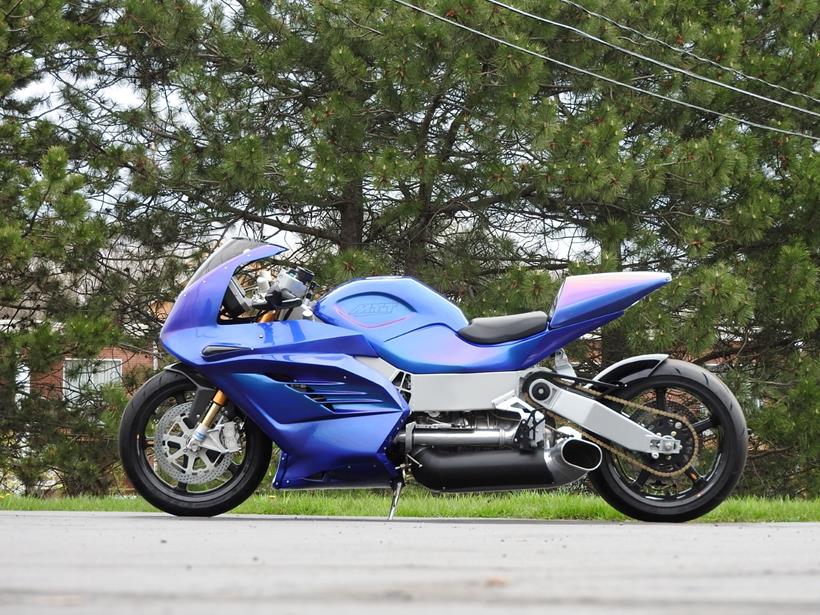
The MTT 420-RR Turbine Superbike may be Superbike by name but it’s definitely Hyperbike by nature. The centrepiece of this crazy creation is a 420hp Rolls Royce turbine engine, usually found in aircraft.
There are only a handful of bikes that are so fundamentally different, that you can’t compare them to anything else, the 420-RR is certainly in a niche of it’s own.
The drama pours on as soon as you fire it up, with unfamiliar clicks of the starter and a high-pitched whirr that builds and builds beyond where you’d expect it to stop. At standstill, it’s a sound straight from Top Gun. A Jet Fighter getting ready to catapult off the flight deck, earplugs recommended.
This bike is a showcase of two industries coming together, intimately, and the result is an outrageous hyperbike that is totally unique in its design. The body work, wheelbase, ergonomics and the general layout of the entire bike are mapped for a rider to be tucked in and stable whilst on the way to its 270mph+ top speed.
MTT states this is “Faster than you will ever dare to go”, and we agree. It would take an incredibly brave soul to attempt maxing it out, even on one of the many closed runways we have in the UK.
It’s probably best sticking to slightly lower speeds and appreciating the experience of a helicopter powered bike without the imminent need for an ejection button.
Even sensible riding can be hazardous – there are reports of MTT’s previous turbine engine powered bike melting the bumpers of nearby cars when waiting in traffic.
When you’ve seen the six-foot flames that can plume out of the exhaust on occasion, it’s not hard to believe.
If you are ever lucky enough to see one, walk right up to it to appreciate what a thing it is – just not too close if the owner has it running.
Highlights: Powered by a Rolls Royce turbine engine / Top speed above 270mph / Nothing else like it
Specs: Engine size: N/A / Power: 420hp / Weight: 227kg / Seat height: 840mm
Price: Approx £223,500
Review: We’ve never tested the 420-RR, but it’s clear to see what an experience it is and we’ve no doubt it is an epic ride at any speed.
2015-on Lightning LS-218
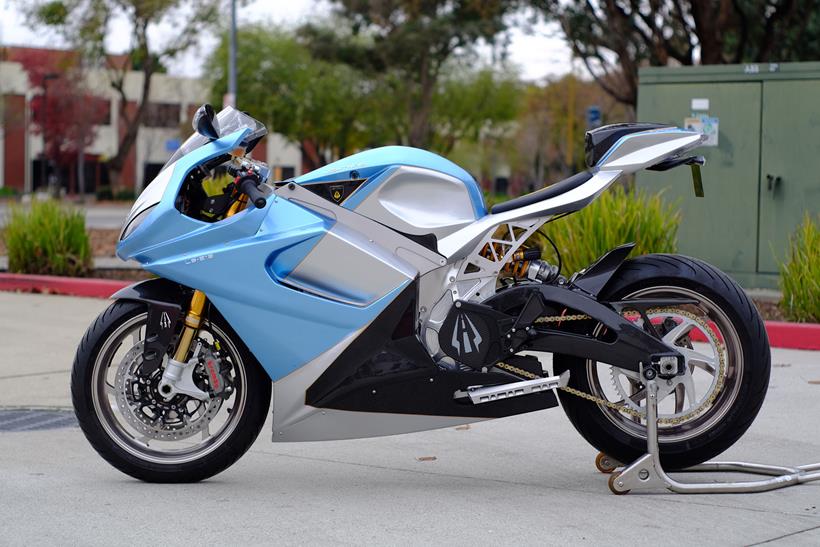
With no gears to manage and no clutch lever to grab, this electric 244hp twist and go Hyperbike has been around since 2015. The American made LS-218 will smash straight though (in relative silence) the 200mph barrier on its way to 218mph.
In the lead up to its release, the prototype was a multiple race winner and it even won overall first place at Pikes Peak. Beating all the combustion engine bikes there with the second place finisher coming in 20 seconds after the LS-218. Lightning showed that electric was not only a match, but it could surpass combustion in race conditions. With it’s thin seat and typical superbike riding position, the production model doesn’t feel miles away from the prototype.
The existence of electric powered bikes is still resisted by many, the sound of a combustion engine being a key attraction to the experience, whilst the absence of a beautiful exhaust note leaves them cold.
We understand this as much as anyone else, but there’s always space for bikes that use their electric anatomy to provide something that combustion doesn’t.
The LS-218 tortures it’s rear tyre with an astonishing 220 ft lbs of torque – that’s more than twice the torque of the KTM 1390 Superduke R! More than the Triumph Rocket 3 Storm, more than any other petrol-powered production bike.
The biggest practicality drawback of electric vehicles is generally limited range and frustratingly long charging times – but with the LS-218, neither of these problems apply. The current offering has a battery range that can be spec’d up to 335 miles on a single charge and be rapidly recharged with 135 miles being added in only 10 minutes at it’s maximum charge rate.
Lightning have fitted the LS-218 with high spec WSBK derived componentry all over, Öhlins FGRT forks, Öhlins TTX rear shock, Brembo GP4-RX brake calipers and T-Drive discs. It’s a genuine alternative if you want a fast Superbike, it’s a little heavier than most at 225kg but the forged aluminium wheels help keep it feeling lively.
We’re impressed at how Lightning have made a good looking, very fast, and high quality electric hyperbike that’s real world usable.
Highlights: Powerful electric Hyperbike / Top Speed of 218mph / Range of up to 335 miles
Specs: Engine size: NA / Power: 244hp / Weight: 225kg / Seat height: 813mm
Price: Approx £31,850
Review: We’ve never tested the LS-218 but from what we’ve seen, it’s a proven Hyperbike with a history of race wins. Likely the most capable sports electric bike currently available.
2015-on Kawasaki Ninja H2R
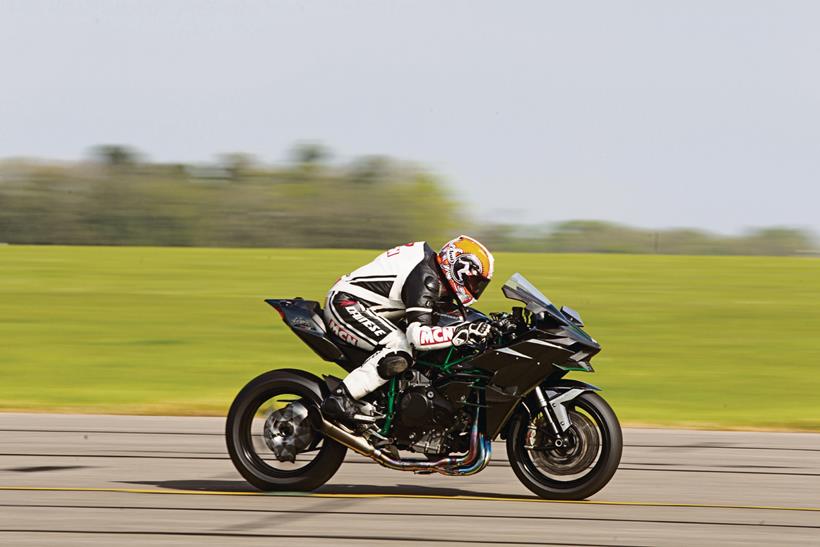
At a time where MotoGP bikes were said to produce around 260bhp, Kawasaki’s claim of 310bhp made an impression for sure. The H2R is a totally in house effort of creating a wild track only hyperbike that’s designed to thrill and showcase just what Kawasaki heavy industries can do.
It’s a powerhouse without question, a supercharged hyperbike from Japan that looks as scary to ride as the bodywork looks evil.
Infamous online, with thousands of comments even today from people pleading to put the Kawasaki Ninja H2R up against anything remotely fast. It’s raced a Jet fighter, a Formula One car (and won both) – WSSP legend Kenan Sofuoğlu rode one to 250mph over a bridge in Turkey.
Before every manufacturer started fitting wings to their superbikes and before MotoGP used downforce winglets like they do today – the Kawasaki H2R was unveiled in 2015 with a totally radical look. Splintered with functional aerodynamic pieces designed to provide unexplored levels of downforce, it made a statement before anyone had even ridden one or seen what it could do.
A Kawasaki Supercharger developed from the ground up, attached to a new inline four powerplant designed to withstand the massive power output. It was clear it would be a savage in a straight line, but Kawasaki also ensured the bike handled well and carried sporty genes usually reserved for their ZX-10R.
It’s a special piece, paintwork with a layer of pure silver and it’s adorned with Kawasaki’s River mark – usually reserved for models of historic significance. That’s how much of a big deal the H2R is, even to Kawasaki.
A new supercharged concept, a new trellis frame, a new single sided swingarm – it was unified effort amongst Kawasaki to put their technology capability on display and it culminated into one of the most bad ass bikes of recent times.
Highlights: One of the fastest production bikes ever / Non road-legal, 200mph, 310bhp supercharged / Order book open and close periodically
Specs: Engine size: 998cc / Power: 310bhp / Weight: 216kg (wet) / Seat height: 830mm
Price: £50,000
Review: The ballistic Ninja H2R was launched at the Lusail MotoGP circuit in Qatar, our chief road tester said:
“Thank you Kawasaki for being so brave – you promised it would be nothing short of epic, and you delivered. What more is there to say? It’s the ultimate top trump card; the fastest, most powerful production bike ever, and it works. Beautifully.” Read the full review of the Kawasaki Ninja H2R on MCN.
Interested in this bike? Find Kawasaki Ninja H2R for sale
2015-2020 Kawasaki Ninja H2
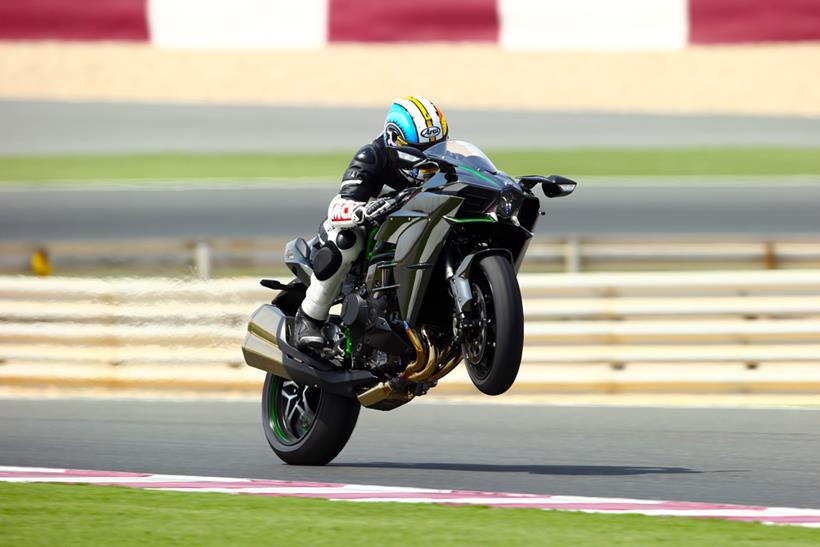
The Ninja H2 is a closely related road going version of the Ninja H2R. It trades ultimate power for engine durability and once Kawasaki have passed it through emissions testing – it still outputs a supercharged 228bhp which qualifies as Hyperbike territory.
In place of the angular front mounted wings are conventional mirrors, the whole package is tailored towards being a road legal machine but still shares the maniac nature of the H2R.
Even though its nearly 100hp down on its track only stablemate, the character of the supercharged engine still delivers face melting acceleration normally not associated with an inline four of this size.
They share the same frame and main components, it’s the engine that’s been fettled with and the bodywork too so it contains the necessary lights needed to be used on the road. Powerful Brembo M50 calipers have also been carried over and the muted exhaust allows you to hear the chirp from the supercharger more clearly.
Even today these are a rare sight to see, no longer available new in the UK market since 2020. If you can find one on the used market it often surpasses the original price from Kawasaki. Not to be confused with the Ninja H2 SX model which is still available today, not quite as insane as the original H2 and orientated towards touring. If the reflective silver paint isn’t your style, the Ninja H2 has spawned a more colourful sibling in the form of the Bimota Tesi H2.
Ten years on since it’s inception, the Ninja H2 is still special and delivers hyperbike performance, hard.
Highlights: Huge performance from supercharged engine / A well-rounded, fun-handling bike / Exceptional reliability record
Specs: Engine size: 998cc / Power: 228bhp / Weight: 214kg (no fuel) / Seat height: 840mm (+/-10mm)
Price: Used £26,000+ | buy from here
Review: Our chief road tester Michael Neeves said this about the H2:
“The unrivalled savagery in which the H2 accelerates never gets old, but its supercharged power delivery is still deliciously smooth and thanks to its excellent electronics”. You can read the full write-up of the Kawasaki Ninja H2 on MCN.
Interested in this bike? Find Kawasaki Ninja H2 for sale.
2021-on Bimota Tesi H2
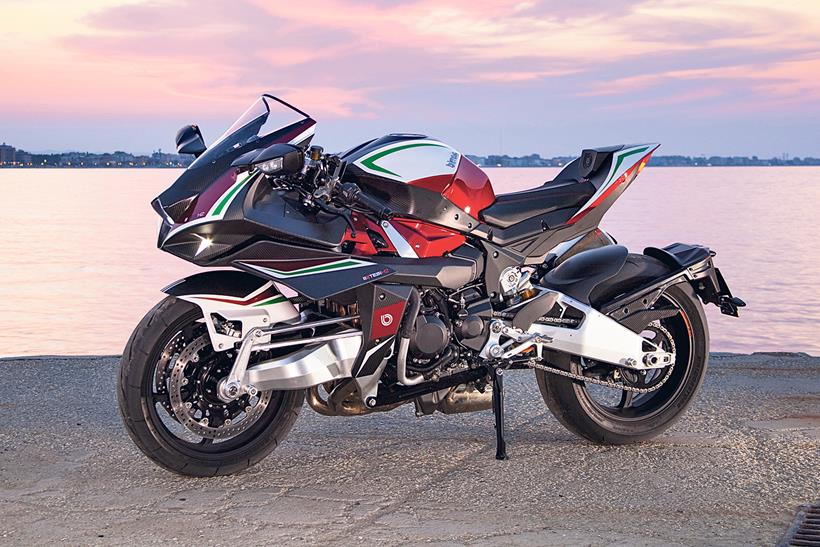
Sharing the same heart and silhouette as the Kawasaki Ninja H2, but with bespoke Bimota touches, is the Bimota Tesi H2.
Conventional forks thrown out in favour of a bespoke steering hub setup, a new in house designed frame, new aluminium swingarm and revised bodywork that’s still very angular but unique to the Tesi.
Kicking out 228bhp, the Tesi can turn the world backwards at will with the supercharger spinning up to 130,000rpm. Kawasaki no longer produce the H2 for the UK market but the Bimota fills the void, although at a hefty £59,000.
It’s an opulent bike no matter what you evaluate, looks, performance, price – it’s a shining example of what manufacturers can do when they take a brave pill and produce something that isn’t destined for every rider but is meant to show off their vision and capability instead.
For the few that do get to ride or own one, it’s a bespoke bike with a bespoke experience, and one of the finest hyperbikes of today.
Highlights: Huge performance from supercharged engine / A well-rounded, fun-handling bike / Exceptional reliability record
Specs: Engine size: 998cc / Power: 228bhp / Weight: 238kg (wet) / Seat height: 825mm
Price: £26,000*
Review: We’ve never tested the Tesi H2, but it’s close relation to the Ninja H2 ensures it’s not going to be bland. You can check out our review of the very similar Kawasaki Ninja H2 on MCN.
Interested in this bike? Find Bimota Tesi H2 for sale
2021-on Suzuki GSX1300R Hayabusa
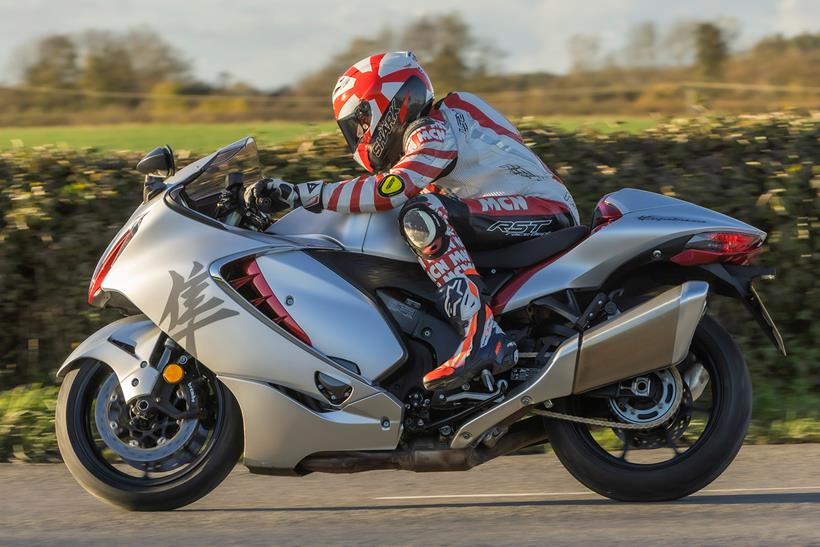
It’s been an icon for its entire lifespan, with a reputation lasting more than a quarter of a century for being one of the fastest bikes you can buy. The Suzuki Hayabusa is one of the most revered Hyperbikes ever to roll out of Japan.
Back in 1999 when the Hayabusa launched, it became the world’s fastest production bike. Suzuki aimed the Busa directly at relieving the Honda CBR1100XX Super Blackbird of that title, and it did just that.
For the uninitiated, the name Hayabusa was selected by Suzuki as it’s the Japanese word for a Peregrine Falcon…and they hunt Blackbirds. Clever.
With it’s alien-like smooth and slippery bodywork, the styling hasn’t always been a favourite amongst casual fans but it’s undoubtedly been an easily recognisable face in any line up of bikes. Aerodynamic efficiency came first and it yielded an aesthetic that’s practically unchanged since the first generation was released.
Whilst the speed of the Hayabusa has always been outstanding, the rest of the bike isn’t bad either. It handles confidently if the rider can persuade all 264kg to comply, feeling planted and capable of soaking up the road. Doubling as a distance machine and not solely an outright speeding fine generator, the Hayabusa is flexible and composed on the road.
It’s still available from Suzuki today, so the icon will be around for a while longer.
Highlights: A Suzuki Hayabusa for the 21st century / Excellent ride quality / Even more grunt in the middle
Specs: Engine size: 1340cc / Power: 187bhp / Weight: 264kg (wet) / Seat height: 800mm
Price: £18,599 | buy from here
Review: We’ve tested each generation of Hayabusa as they came, our road tester said this about the latest offering:
“Headline-grabbing speed figures require a number of specific features and it is these that make the Suzuki such a stand-out bike. Its aerodynamic look is unique, its stability at speed unmatched and above all, its engine is outstanding in how it delivers smooth and uninterrupted roll-on thrust in a way you only get through cubes and not forced induction.”
You can read the full review of the current Suzuki Hayabusa on MCN.
Interested in this bike? Find Suzuki GSX1300R Hayabusa for sale.
2012-2020 Kawasaki ZZR1400

Treading the line between Hyperbike and sports touring, is the internationally loved Kawasaki ZZR1400. It claimed the title of fastest accelerating production bike when it was released in 2006 and cracked the 200bhp mark well before it became common amongst superbikes.
It’s blend of power, comfort, and sporty handling cemented it as a true hyper do it all. With 200hp on tap, it has plenty of go but remains totally predictable.
It’s common to see them used as mile munching tourers or armed with a top box heading into a rainy commute, stealing thunder from adventure bikes that are often deployed when the going gets tough.
If you are of the sporty persuasion, the ZZR1400 makes much more sense. It’s got a wide fairing with plenty of wind protection, it’s more comfortable than its sharper Superbike cousins, and with more torque too. It was dropped from Kawasaki’s UK lineup in 2020, but there’s a great used market for it, offering immense performance for around £5000 and up.
Highlights: Fastest accelerating bike on the road at launch / Smooth engine with loads of torque / Comfortable over long distances.
Specs: Engine size: 1441cc / Power: 200bhp / Weight: 239kg (wet) / Seat height: 800mm
Price: Used £5000 – £12,000 | buy from here
Review: When we tested the ZZR1400, our road tester said:
“Then once out on the open road, the Kawasaki is utterly slick, steadfast and smooth. Sure, it’s not exactly nimble or flickable, but it is surprisingly easy and predictable with a monstrous powertrain that still delivers a hyper drive few other motorcycles can match.” You can read the full review of the Kawasaki ZZR1400 on MCN.
Interested in this bike? Find Kawasaki ZZR1400 for sale.
1997-2005 Honda CBR1100XX Super Blackbird
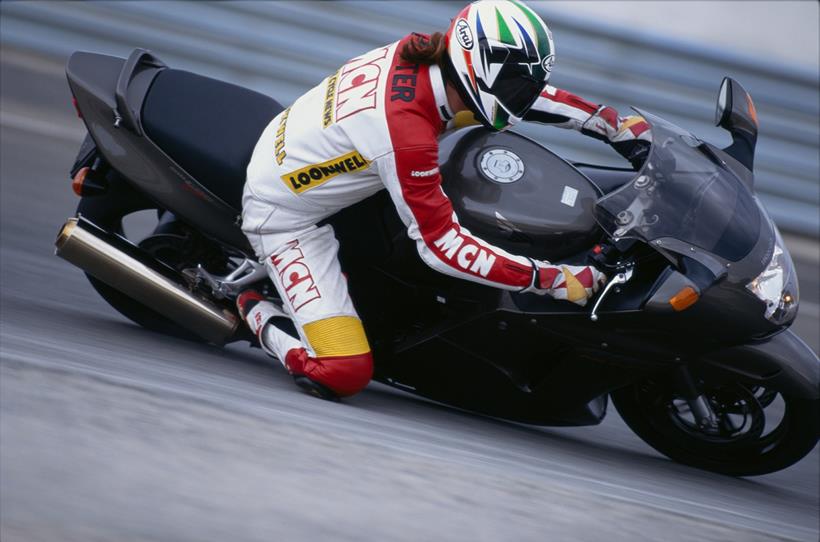
The oldest bike in this collection, the Honda CBR1100XX Super Blackbird is a milestone for what was possible back in 1997 when it launched. Analogue and understated, this is a bike you can ride sensibly and have no idea what’s lurking below the fuel tank.
It’s as well behaved as the rider’s right hand, docile when unprovoked but with the means to turn the road into a grey blur once it’s let loose.
It was the world’s fastest production bike for 2 years until the Suzuki Hayabusa came along in 1999. Honda named it after the ultra-pointy Lockheed SR-71 Blackbird jet, which was a long-standing record holder as the fastest airplane. (Ironically, it also retired in 1999, the same year the Hayabusa took the speed record from Honda).
For years they’ve been used as a comfortable hyper-tourer when doing big miles. You can be confident when sightseeing throughout Europe that it needs nothing but fuel and tyres as the Blackbird is Honda sorted, inside out. Some examples might need a little attention today considering their age, but nothing surprising.
If you want cheap and reliable speed, the Blackbird can be picked up for less than £2000 on the used market. It appeared that Honda expected their Blackbird to also be a decade spanning record holder of speed, although it wasn’t meant to be.
Highlights: Sensible and utterly insane at the same time / Was the world’s fastest production bike when launched / Legendary Honda reliability
Specs: Engine size: 1137cc / Power: 164bhp / Weight: 223kg (wet) / Seat height: 810mm
Price: Used £1500 – £3300 | buy from here
Review: When MCN tested the Blackbird, we said it was:
“Purpose-built as a ballistic hyper tourer, the Blackbird is classic Honda: both an exercise in no-compromise corporate dominance and also a fabulously refined, comfortable, slick and usable motorcycle in its own right.” You can read the full review of the Honda CBR1100XX Super Blackbird on MCN.
Interested in this bike? Find Honda CBR1100XX Super Blackbird for sale.
So there you have it, a collection of some of the most ballistic and whackiest hyperbikes to exist. Creations like these are not born by accident so we aren’t holding our breath expecting more bikes like these to hit the showrooms this year.
We’re hopeful that there’ll always be manufacturers bold enough to build something that doesn’t fit the industry mold, if arrives in the form of a hyperbike, we’re excited to see it.
















